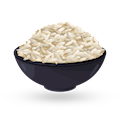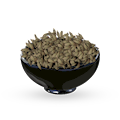Sindhi biryani is one of the most popular Pakistani dishes originating from the province of Sindh, hence the name. It is prepared with a huge variety of ingredients, including basmati rice, tomatoes, yogurt, potatoes, onions, prunes, spices (red chili powder, ginger, cardamom, turmeric, cloves, cumin, cinnamon, coriander, mint, and bay leaves), and either chicken, goat, or lamb meat.
This layered rice dish is usually served with raita on the side.
MAIN INGREDIENTS
Jeera rice is a simple Indian dish made with rice and cumin seeds. Basmati rice is typically mixed with cumin seeds which have been fried in ghee, and the dish can be additionally enriched with cinnamon, cardamom, bay leaves, cloves, and coriander.
Once prepared, jeera rice can be served on its own or as an accompaniment to a variety of Indian dishes. The word zeera is Hindi-Urdu for cumin seeds, hence the alternative spelling – zeera rice.
Bannu pulao is a traditional mixed rice dish originating from Bannu, a district in the Khyber Pakhtunkhwa province of Pakistan, typically made with a specific type of long grain rice, usually basmati, cooked in a rich and flavorful broth that is often infused with various spices such as cloves, cardamom, black pepper, and cinnamon.
The rice is cooked with pieces beef (including the bone and marrow), which are tenderized and flavored during the cooking process. It's characterized by its aromatic and slightly spicy taste, with the meat being exceptionally tender and flavorful.
Ghee (clarified butter) is commonly used in the preparation, adding to the richness of the dish.
Sindhi pulao is a traditional dish hailing from the province of Sindh. This dish is often compared to and even mistaken for another Sindhi specialty called sindhi biryani as the key ingredients of both dishes include rice and meat or vegetables.
Other than that, sindhi pulao and sindhi biryani are two entirely different dishes. Unlike the biryani, in which the ingredients are typically layered, the pulao tosses everything together into a one-pot meal. Other key differences between the dishes include their different methods of preparation and the number of spices used in each.
TasteAtlas food rankings are based on the ratings of the TasteAtlas audience, with a series of mechanisms that recognize real users and that ignore bot, nationalist or local patriotic ratings, and give additional value to the ratings of users that the system recognizes as knowledgeable. TasteAtlas Rankings should not be seen as the final global conclusion about food. Their purpose is to promote excellent local foods, instill pride in traditional dishes, and arouse curiosity about dishes you haven’t tried.












